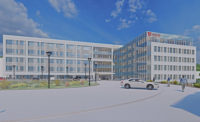The retrofit shelters recently were constructed, with limited demolition, entirely within the schools’ existing corridor walls in a span of 10 weeks, permitting the entire project to be completed during summer recess. Henry County also took advantage of a FEMA Hazard Mitigation Grant to pay for 75% of construction costs.
The corridor retrofit also has additional benefits. Because by code a hallway cannot be blocked with furnishings, no area reduction is required. Every square foot of the corridor is efficiently used as shelter.
As another benefit, the enclosure panels provide handgun-bullet resistance of up to 0.45 caliber, so the hallway can be used as a lockdown area in the event of a threatened or actual shooting incident.
With the large number of existing schools in our nation and the challenge to make the students within them safer, engineers and architects must step forward with creative and economic solutions to offer the modifications these facilities require to ensure student safety. We offer one alternative solution whereby the needs of these buildings and their occupants can be met.
Our industry needs to take on the challenge of helping the nation bring its existing school facilities up to the safety standards expected of new construction. Doing anything less divides our student population into two groups, the relative few that have adequate protection in new schools and the vast majority of students who are “sheltered” in schools that do not.
We must do better than that.
Jason Pirtle, P.E. is a structural engineer who has been involved in numerous tornado safe rooms projects including standalone shelters, shelter additions and safe room retrofits. He is a professional member of the National Storm Shelter Association (NSSA) and is an NSSA approved third party reviewer. Jason can be reached at jasonpirtle12@gmail.com.


Post a comment to this article
Report Abusive Comment